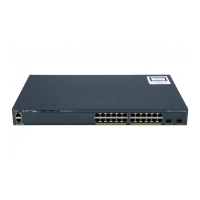Chapter 13: Quality of Service 243
Section 13-2
Table 13-5 Queue Scheduling and Congestion-Avoidance Thresholds
Queue
Type
Threshold Number
CoS: Percentage Tail-Drop or Low%/High% WRED
Standard Queue 1 Standard Queue 2 Standard Queue 3
T1 T2 T1 T2 T1 T2
2q2t 01: 80% 2,3: 100% 4,5: 80% 6,7: 100% — —
1p2q2t 0,1: 50% 2,3: 60% 4: 80% 6,7: 100% — —
1p3q1t 0,1: 100% — 2,3,4: 100% — 6,7: 100% —
1p2q1t 0,1,2,3:
70%/100%
— 4,6,7:
70%/100%
———
Table 13-6 Switch Port Buffer Division Defaults
Port Type Low Priority Medium
Priority
High Priority Strict Priority
2q2t 80% (queue1) — 20% (queue2) —
1p2q2t 70% (queue1) — 15% (queue2) 15% (queue3)
1p3q1t 25% (queue1) 25% (queue2) 25% (queue3) 25% (queue4)
1p2q1t 50% (queue1) — 30% (queue2) 20% (queue3)
Estimate the ratio of normal (low and high priority) and strict-priority traffic to
the total amount of traffic going out of a switch port. Use the queue1, queue2,
and optionally queue3 values to set the percentages (1 to 100) for the standard
transmit queues. Use the queue-priority value to set the percentage (1 to 100) of
the strict-priority queue. These values must total 100 percent.
Table 13-6 lists how the switch port buffers are divided by default.
b. (Optional) Adjust the weighting of transmit queue servicing:
(interface) wrr-queue bandwidth weight1 weight2 [weight3]
For port-type 2q2t, 1p2q2t, 1p3q1t, and 1p2q1t, the standard queues are serv-
iced in a WRR fashion. The strict-priority queue is always serviced, regardless of
any other queue. Then each standard queue is serviced in turn, according to its
weight value; each queue’s weight is relative to the others.
By default, ports with two queues have a ratio of 4:255, and ports with three
queues have a ratio of 100:150:200. (When QoS is disabled, all queues are equal-
ly weighted at 255.)

